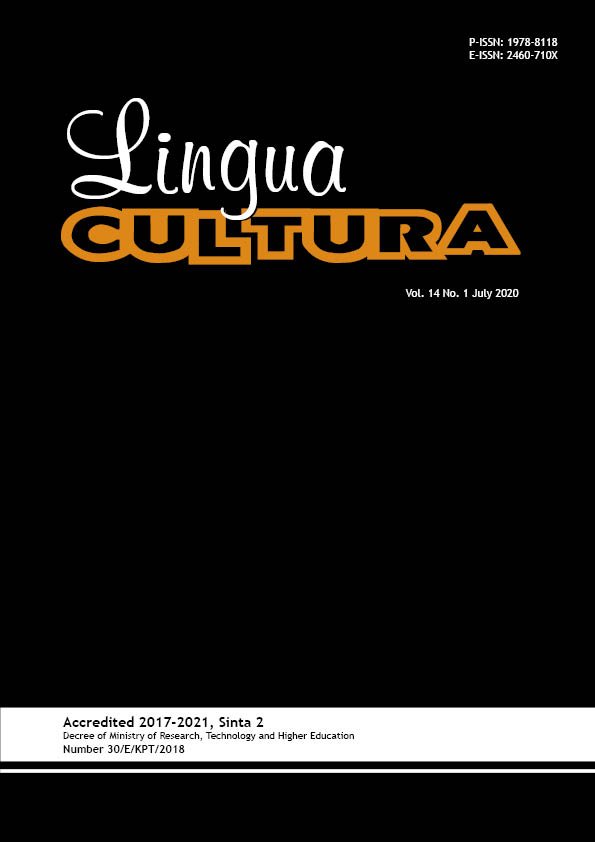Syllable Structure and Nasalization Change in Makassar Language
DOI:
https://doi.org/10.21512/lc.v14i1.6357Keywords:
verb, Makassar language, change in syllabic structure, nasalization, geminationAbstract
The research discussed two points of phonological process related to changes in the syllable structure and nasalization in Makassar language. The data were analyzed by distributional and identity methods using a direct sorting technique. The affixes that form the verb of Makassar language were sorted by the type of prefix. Researchers also used the direct sorting form of phonetic articulation. The steps of analyzing data used Sudaryanto’s theory. The affixes that discussed in the research were /ak-/ and /an-/. The phonological process was described by using the theory of generative phonology of Schane. The result shows the types of sound and syllabic changing. They are; (a) sound changing of [ak-] becomes [ʔ] named glottalization; (b) sounds changing of [ak-] becomes nasalization; (c) gemination of [ak-] and [an-]; (d) sound changing of / an-/ becomes [aŋ-]; (e) sound release and insertion of prefix /an-/; (f) sound change and nasalization. The distinctive feature is used to explain the rules of the phonological process.
References
Amir, J. (2012). Mekanisme pembentuk verba berafiks dalam bahasa Makassar. Retorika: Jurnal Bahasa, Sastra, dan Pengajarannya, 8(1), 1-26. https://doi.org/10.26858/retorika.v8i1.509.
Anasti, R. R., Ridanta, S., & Ramadhan, S. (2020). Proses fonologis generatif bahasa prokem remaja di Indonesia. Deiksis, 12(1), 69-74. http://dx.doi.org/10.30998/deiksis.v12i01.3799.
Arifiani, E., & Subiyanto, A. (2019). Sistem perubahan struktur silabel dan netralisasi vokal dalam bahasa Sasak dialek Bayan. Jalabahasa, 15(1), 36-47.
Banik, L. A. (2017). Fonologi bahasa Kaumana Kolana. Retorika, 3(1), 145-158. https://doi.org/10.22225/jr.3.1.164.145-158.
Basang, D., & Arief, A. (1981). Struktur bahasa Makassar. Jakarta: Pusat Pembinaan dan Pengembangan Bahasa Departemen Pendidikan dan Kebudayaan.
Charmilasari. (2016). Sistem fonologis bahasa Makassar dialek Cikoang kabupaten Takalar. Jurnal Onoma: Pendidikan, Bahasa, dan Sastra, 3(1), 72-89. http://dx.doi.org/10.30605/onoma.2017.912.
Dominikus., Pastika, I. W., & Putra, A. A. (2016). Proses dan kaidah fonologis posleksikal bahasa Helong kajian generatif. Linguistika: Buletin ilmiah Program Magister Linguistik Universitas Udayana, 23, 148-157.
Haslinda. (2018). Kemampuan menentukan affiks pada teks cerita bahasa Makassar â€I Jamila Daeng Kanang†Siswa kelas IX SMP Islam Darussalam Pannyangkalang (Thesis). Makassar: Universitas Negeri Makassar.
Gane, M., Abdullah, W., Purnanto, D. (2019). Seluk beluk prefiks resiprokal ki- dalam bahasa Loloda di Halmahera Utara provinsi Maluku Utara. Mozaik Humaniora, 19(1), 63-73. http://dx.doi.org/10.20473/mozaik.v19i1.11860.
Muslihah. (2018). The analysis of loan words of English language transformed into Japanese language (Study of generative transformational phonological). Izumi: Jurnal Bahasa, Sastra, dan Budaya Jepang, 7(2), 73-83. https://doi.org/10.14710/izumi.7.2.73-83.
Nafisah, S. (2017). Proses fonologis dan pengkaidahannya dalam kajian fonologi generatif. Deiksis, 9(1), 70-78.
Sartini, N. W. (2019). Bahasa pergaulan remaja: Analisis fonologi generatif. Mozaik: Jurnal Ilmu Humaniora, 12(2), 36-47.
Schane, S. A. (1973). Generative phonology. New Jersey: Prentice-Hall.
Sudaryanto. (2015). Metode dan aneka teknik analisis bahasa. Yogyakarta: Sanata Dharma University Press.
Swadana, W. (2018) Fonologi bahasa Bali dialek Jembrana. Joish: Jurnal Ilmu Sosial dan Humaniora, 7(1), 77-86. http://dx.doi.org/10.23887/jish-undiksha.v7i1.13670.
Downloads
Published
How to Cite
Issue
Section
License
Copyright (c) 2020 Lingua Cultura

This work is licensed under a Creative Commons Attribution-ShareAlike 4.0 International License.
Authors who publish with this journal agree to the following terms:
a. Authors retain copyright and grant the journal right of first publication with the work simultaneously licensed under a Creative Commons Attribution License - Share Alike that allows others to share the work with an acknowledgment of the work's authorship and initial publication in this journal.
b. Authors are able to enter into separate, additional contractual arrangements for the non-exclusive distribution of the journal's published version of the work (e.g., post it to an institutional repository or publish it in a book), with an acknowledgment of its initial publication in this journal.
c. Authors are permitted and encouraged to post their work online (e.g., in institutional repositories or on their website) prior to and during the submission process, as it can lead to productive exchanges, as well as earlier and greater citation of published work.
USER RIGHTS
All articles published Open Access will be immediately and permanently free for everyone to read and download. We are continuously working with our author communities to select the best choice of license options, currently being defined for this journal as follows: Creative Commons Attribution-Share Alike (CC BY-SA)


















